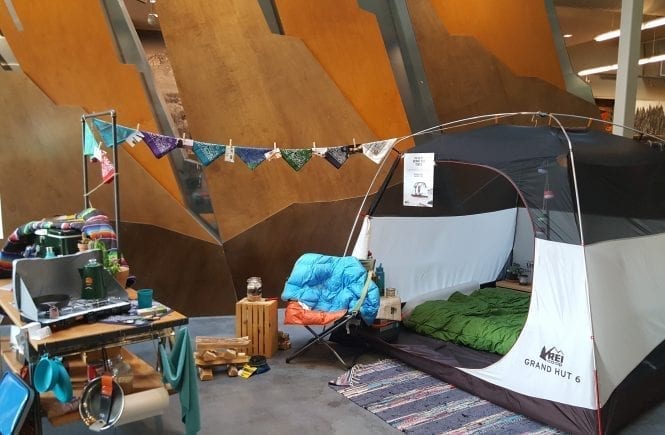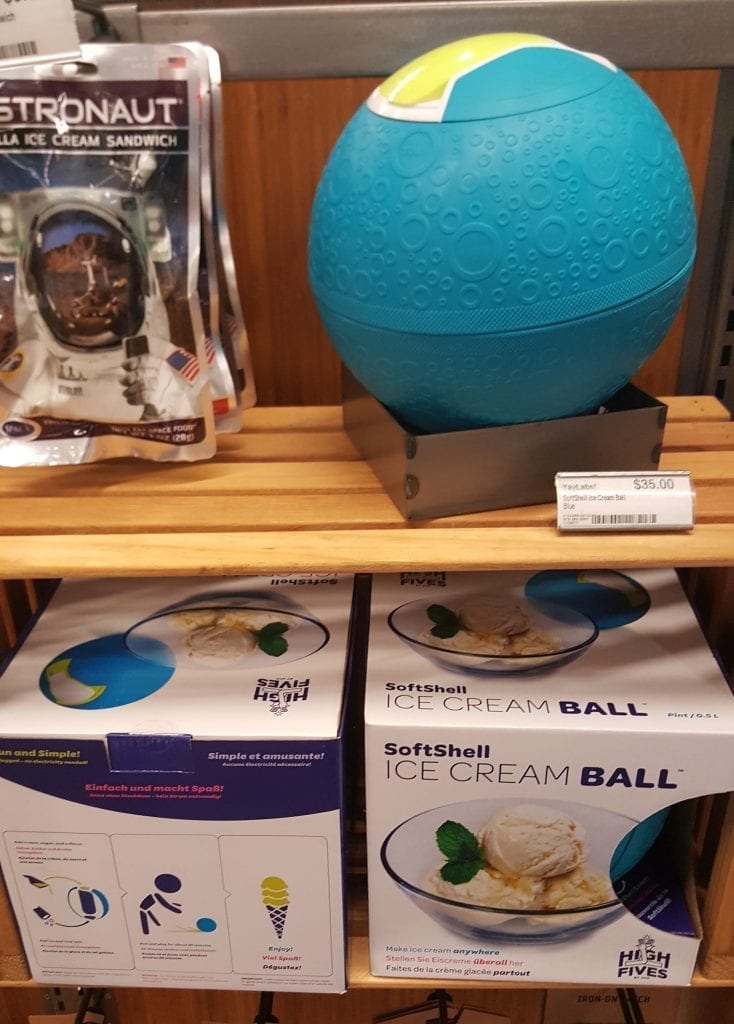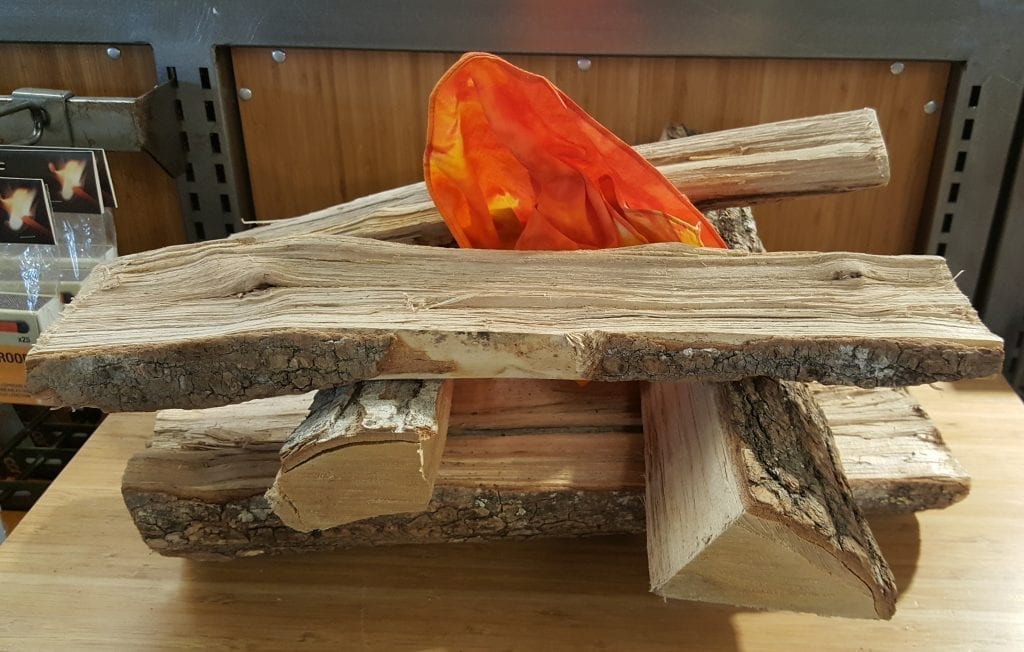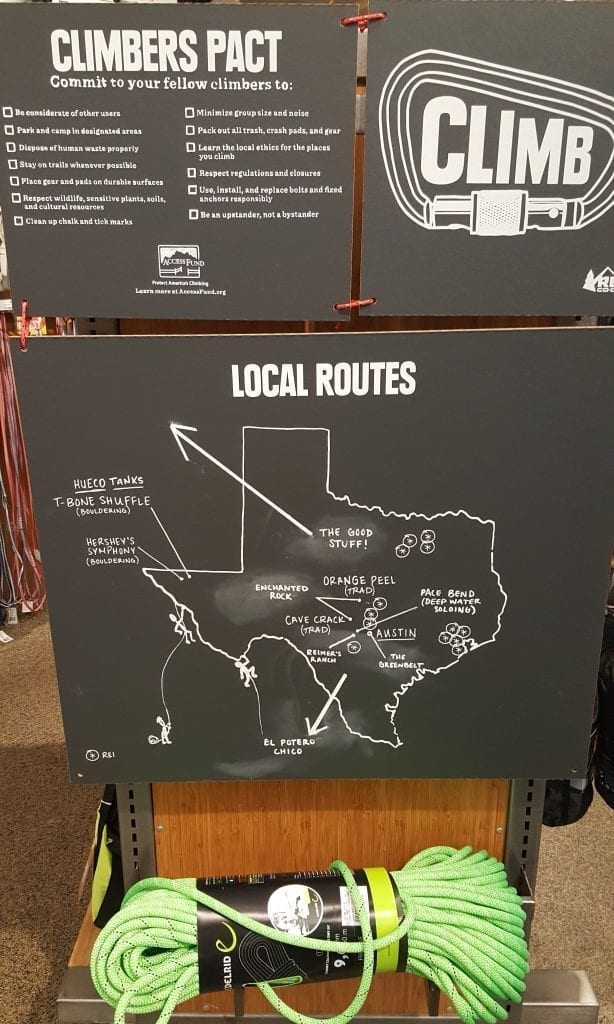REI Round Rock – Urban Survival Talk
REI Round Rock was hosting a survival seminar called, Prepare for the Unexpected: Urban Emergency Preparedness, which I was really excited to attend. So I made the drive from Bastrop, TX, to Round Rock for the presentation that evening. When I arrived, I was really impressed to see the design of the REI Round Rock building on the outside, and was in for a big surprise with what I was going to see on the inside!
When you walk into the store, you are greeted by a large protruding artistic mountain range and camping demo site – with a view into the store and the floating half-floor community center between the first and second floors of the building!
The front camping demo exhibit – which can be adjusted seasonally for special products – features a geared-out tent and outdoor fire-pit sitting area next to a display area covered with cookware!
Near the checkout registers was an information board highlighting the sustainability features of the building, including solar power, lighting strategy, materials and resources, building design and store operations. This location uses 50% less energy than most other stores with the current industry standards – especially with it’s LEED Certification as a pilot model for other retail stores!
This video tour of the REI Round Rock store points out the many ways this store uses recycled materials as part of it’s construction and uses in product display boards!
The smaller description boards break down the sustainability strategies for the building into:
- Lighting Strategy – Eliminating nearly all incandescent bulbs to install ceramic metal-halide fixtures, solatubes and solabells for natural lighting, and implementing sensors to turn off lights when not in use.
- Materials & Resources – Reusing reclaimed materials like carpet fibers, recycled rubber from tires/tennis shoes and other post-industrial waste.
- Store Operations – Recycling cardboard and batteries, providing amenities for employees like bike racks and shower facilities, and maintaining green housekeeping standards.
- Building Design – Constructing with highly efficient insulation and carbon dioxide sensors, a ‘cool roof’ to reflect solar radiation, and installing energy star-rated appliances and water-conserving bathrooms.
- Solar Power – Incorporating PV technology for natural lighting, generating 8% of the store’s electricity, and integrating a solar hot water system to heat 70% of the store’s water.
On the community center half-floor, there were several resources for guests, including this black-board calendar highlighting upcoming events mixed with clips for hanging nature photos!
I arrived a little early, so I walked around the store looking at the various displays installations, products and artistic chalk-boards throughout the store.
The first product display I came across was the bikepacking exhibit, which I thought was a clever combination of backpacking and biking – which I’ve noticed is on an up-tick with travelers on my personal adventures.
“Part backpacking and part bike-touring, bikepacking is a fun choice for cycling buddies, couples and families who ride together. It lets you cover more miles than hiking, plus you can access dirt roads and trails that are inaccessible to other vehicles. Rides range from local overnighters all the way up to epic cross-country trail rides.” — REI Bikepacking Articles
A unique product in the store was the Nemo Stargaze Recliner, a small folding chair that lets the ‘sitter’ rock or recline in the chair! A little out of my price range, but a cool concept!
Another unique product in the cookware section was the YayLabs! SoftShell Ice Cream Ball, a DIY method for ice cream in a form of a ball to roll around to activate the ice cream process!
Also in the cookware section was the BioLite technology, energy efficient lights and camp stoves that convert the burning process into electrical energy to charge devices off-grid. I got to see one of these in action during the program at Lost Valley when we talked about alternative energies.
I thought this fire was a creative part of the outdoor cookware section, so I took a picture of it!
Throughout the store were chalkboards, like the ones featured below, that highlighted important information around Texas like popular destinations, upcoming local events, and other fun facts!
The Prepare for the Unexpected: Urban Emergency Preparedness presentation was about to begin, so I made my way back to the community center floor – where Thomas the presenter had the slideshow, signage and some survival products laid out for us!
Thomas our presenter had a sign laying out the 10 essentials for preparedness, which include:
- Navigation (map and compass)
- Sun Protection (sunglasses and sunscreen)
- Insulation (extra clothing)
- Illumination (headlamp/flashlight)
- First-Aid Supplies
- Fire (waterproof matches/lighter/candles)
- Repair Kits and Tools
- Nutrition (extra food)
- Hydration (extra water)
- Emergency Shelter
Thomas had been working for REI for several years, and had taught this class a lot, so he was really engaging and informed on these topics.
He broke the presentation into 3 main parts for us to easily remember: (1) Plan, (2) Prepare, (3) Practice
Thomas continued this bite-sized style with easy to remember acronyms because during times of stress and chaos, its easier to remember small/short bits of information, like STOPAA (Stop, Think, Observe, Plan, Act, Adapt) and the Rule of 3’s (3 hours without Shelter, 3 Days without Water, and 3 weeks without Food.)
Thomas concluded the presentation with an emphasis on going and doing these steps to prepare with a quote from Kahlil Gibran, “A little knowledge that acts is worth infinitely more than much knowledge that is idle.”
On the last slide of the presentation, Thomas ended with a resource list before segueing into a store tour of some survival product recommendations. The resources listed included:
- ready.gov
- community.fema.gov
- fema.gov
- rei.com/learn/expert-advice
- Deep Survival: Who Lives, Who Dies, and Why – Book
- When All Hell Breaks Loose: Stuff You Need To Survive When Disaster Strikes – Book
Insights
While I enjoyed the presentation, it was fairly basic and more like an intro – which Thomas explained at the beginning – so it was more like a refresher course for me personally.
However, what I really took away from the experience was getting to see the REI building design with recycled and energy efficient materials, the product display installations for layout inspiration, and a few stories and resources from the presentation that apply to Texas disaster scenarios.
Resources
- REI – Round Rock Store Webpage
- REI Classes and Events Webpage
- REI – Expert Advice Webpage
- ready.gov
- community.fema.gov
- fema.gov
Articles
- How to Get Started Bikepacking – REI Article
- REI Round Rock Second Gen Green Store To Use 48% Less Energy – Jetson Green Blog
- Weekly LEED roundup – 11/6/09 – Mother Nature News Article
Videos

























